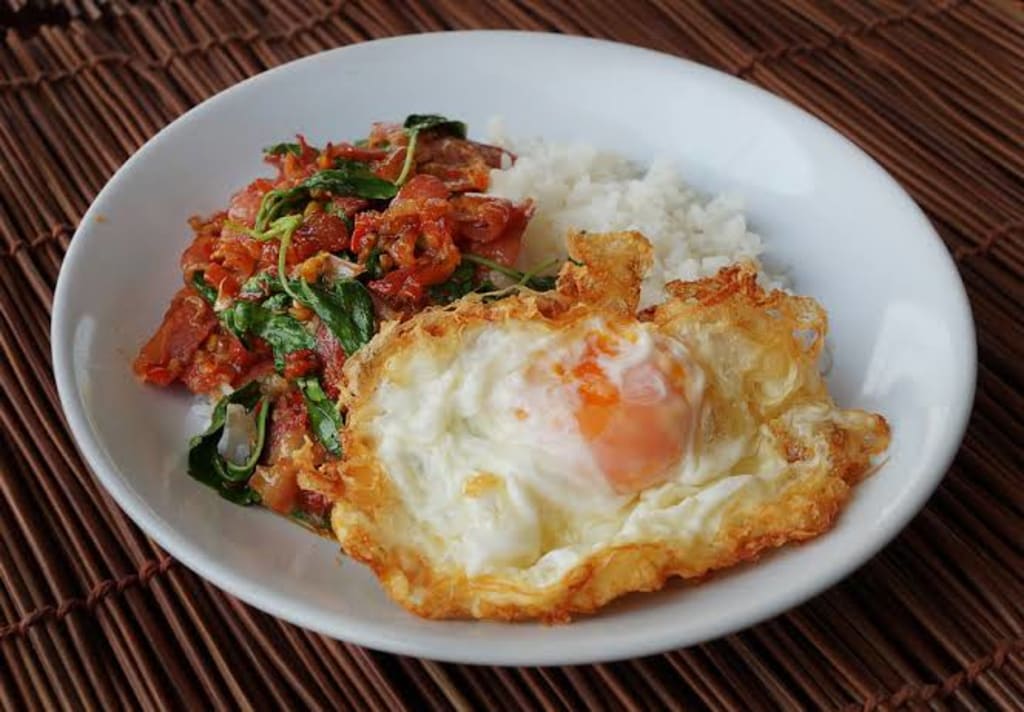Pad kaphrao challenge is a genuine taste of Thailand's most cherished dish
Pad kaphrao is often overshadowed by pad Thai abroad, but is much loved in Thailand.

Pad kaphrao, with its compelling flavor and widespread popularity, stands as a strong contender for the title of Thailand's most beloved dish, offering a speedy and uncomplicated preparation process. It graces the offerings of street vendors, filling the atmosphere with its unique and fiery fragrance, while also finding its place on the menus of upscale dining establishments and the shelves of convenience stores.
Be that as it may, abroad it is eclipsed by any semblance of cushion thai and green curry - and when it highlights on menus, the fixings will generally vary from those utilized in Thailand.
This weekend, Thailand's most memorable public cushion kaphrao contest was held, pointing toward tracking down the best recipe.
"The main issue is that the kaphrao we have in Thailand and kaphrao we have in UK, in the States and in other European nations - for what reason is it so unique?" said Yuthasak Supasorn, the legislative head of The travel industry Authority of Thailand, which facilitated the occasion.
"[People will] understand what the valid recipe of cushion kaphrao is. No more child corn, no more onion, no more carrots," Yuthasak expressed, alluding to a portion of the disputable fixings that have been added to the dish. Such augmentations can make offense cushion kaphrao idealists.
Gourmet specialists participating in this end of the week's opposition were more loosened up about utilizing vegetables. "It is a simple dish - it's bean stew, basil, garlic and meat, so anything that vegetable you have left in the refrigerator you can place it in," said Chakkrit Chuma, 30, who brought home the championship. Yet, trading the key fixings - utilizing some unacceptable kind of basil - wouldn't give a similar taste, he added.
Chakkrit, hailing from Lampang in northern Thailand and mentored by his chef father, highlighted another common mistake in preparing Pad kaphrao: an excessive spiciness. He emphasized that the dish should first deliver a saltiness, followed by sweetness, and then gradually introduce the heat and spiciness in your mouth. Chakkrit employs seven different types of chilis in his cooking to achieve a diverse flavor profile.
Meanwhile, Paphakorn Niyomsub, aged 38 and also a finalist in the competition, stressed the importance of ensuring that the dish remains aromatic and dry, avoiding excessive oil.
Paphakorn's dedication to perfecting his Pad kaphrao recipe for the competition was so intense that anyone entering his home would instantly sneeze due to the aroma. His passion for this dish began during his boarding school days, where he would always make a beeline for a local Pad kaphrao shop upon returning home. It was there that he learned the art of crafting this flavorful meal.
Comparatively, Pad thai enjoys greater international fame, largely due to its name recognition. Moreover, it's appreciated for its mild spice level and easy-to-enjoy nature.
The widespread recognition of Pad thai can be attributed in part to Field Marshal Plaek Phibulsongkram, also known as Phibun, who served as the Thai prime minister in 1938. He initiated various cultural reforms aimed at reinforcing national identity, including changing the country's name from Siam to Thailand and offering guidance on attire, language, and cuisine. His efforts to popularize noodle consumption ultimately gave rise to the beloved dish, pad thai.
Paphakorn, in the same way as other Thais, said he didn't frequently eat cushion thai. Pad kaphrao was Thailand's actual public dish, he said.
Broadly, it was this feast that the Wild Pigs football crew said they yearned for after they became caught in the haziness of a cavern in Chiang Rai in 2018.
Pajaree Pakprom, 60, who was among the people who had come to test the food and watch the Pad kaphrao challenge in Bangkok, said she figured more outsiders could partake in the dish.
She encouraged individuals to have a go at eating it with a seared egg on top. "Without a fried egg, it's not as scrumptious. They go well together," she said. The dish was sweet-smelling and helpful. "Regardless of whether you purchase and keep it to eat later, it's a benefit. It doesn't lose its taste."
The travel industry authority desires to draw in guests who need to come to attempt the genuine article. "We know that [food] is the most effective way to expand the spending per outing of the vacationers or voyagers who come to Thailand," Yuthasak said. The power gauges that food represents around 20% of a traveler's spending during an outing, and desires to build this to 25%.
For homegrown sightseers, as well, he said, individuals didn't discuss where they would remain yet all things being equal "where we need to go, what we need to eat".
The efforts of the travel industry body to ensure the authenticity of a dish that holds significant popularity at home but often remains overshadowed abroad is commendable. Preserving the true essence of a country's culinary heritage is a vital aspect of promoting tourism and cultural exchange.
Food is an integral part of any culture, and when travelers have the opportunity to savor a dish that authentically represents a region's flavors and traditions, it becomes a memorable part of their travel experience. By safeguarding the authenticity of such dishes, the tourism body not only enriches the experiences of international visitors but also contributes to the broader recognition and appreciation of their nation's culinary treasures on the global stage.
In doing so, not only does the tourism body promote the uniqueness of their country's cuisine, but they also open doors to culinary tourism, attracting food enthusiasts from around the world. This, in turn, can boost local economies, create job opportunities, and foster cultural understanding.
In conclusion, the tourism body's commitment to preserving the authenticity of a beloved local dish is a worthy endeavor, as it not only elevates the culinary tourism experience but also helps shine a spotlight on the rich and diverse flavors of their homeland.
About the Creator
Enjoyed the story? Support the Creator.
Subscribe for free to receive all their stories in your feed. You could also pledge your support or give them a one-off tip, letting them know you appreciate their work.





Comments
There are no comments for this story
Be the first to respond and start the conversation.